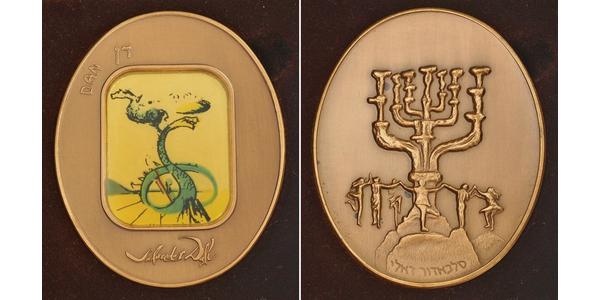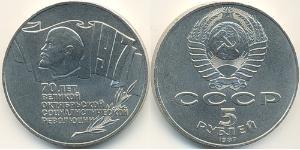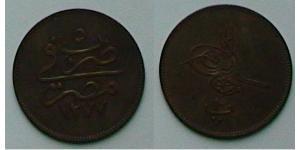(sold for $32.0)
1973, Israel (Republic). Beautiful Bronze "Dan Tribe" Medal by Salvador Dali.
Mint Year: 1973 Denomination: 10 Lirot - Israeel´s 25th Anniversary Condition: Minor spots in reverse, otherwise uncirculated and in original box of issue! Material: Bronze (with a colored plastic in obverse - as made!) Weight: 153.47gm Diameter: 76mm
According to the Hebrew Bible, the Twelve Tribes of Israel or Tribes of Israel (Hebrew: שבטי ישראל) were said to have descended from the 12 sons of the patriarch Jacob (who was later named Israel) by two wives, Leah and Rachel, and two concubines, Zilpah and Bilhah.
The Tribe of Dan (Hebrew: דָּן), meaning, "Judge," was one of the tribes of Israel, according to the Torah. They were allocated a coastal portion of land when the people of Israel entered the Promised Land, later moving northwards. According to the Torah, the tribe consisted of the descendants of Dan, a son of Jacob and Bilhah, Rachel's maidservant (Genesis 30:4). In the biblical account, Dan is one of the two children of Bilhah, the handmaid of Jacob's wife Rachel, the other child of Bilhah being Naphtali. Scholars see this as indicating that the authors saw Dan and Naphtali as being not of entirely Israelite origin (being descendants of handmaids rather than of full wives).
Some have noted that the territory of the handmaid tribes happens to be the territory closest to the north and eastern borders of Canaan, thus exposing them to Assyria and Aram. However, other tribes born to wives, including the firstborn Reuben, were also included on the eastern outskirts, and immediately adjacent to Israel's more traditional enemies at the time of their entry to Canaan, the Moabites and Ammonites.
In the Biblical census of the Book of Numbers, the tribe of Dan is portrayed as the second largest Israelite tribe (after Judah). Some textual scholars regard the census as being from the Priestly Source, dating it to around the 7th century BC, and more likely to reflect the biases of its authors. In the Blessing of Moses, which some textual scholars regard as dating from only slightly earlier than the deuteronomist, Dan is prophesied to "leap from Bashan"; scholars are uncertain why this should be since the tribe did not live in the Bashan plain, east of the Jordan.
According to the biblical narrative, following the completion of the conquest of Canaan by the Israelite tribes after about 1200 BCE, Joshua allocated the land among the twelve tribes. Dan was the last tribe to receive its territorial inheritance. The land originally allocated to Dan was a small enclave in the central coastal area of Canaan, between Judah, Benjamin, Ephraim and the Philistines.
To the north the territory of Dan abutted Joppa, the modern Jaffa. This territory, not very extensive originally, was soon diminished by its dangerous neighbors, the Philistines. The tribe was only able to camp in the hill country overlooking the Sorek Valley, the camp location becoming known as Mahaneh Dan ("Camps of Dan"). (Joshua 19) The region they were trying to settle extended south into the Shephelah in the area of Timnah; as a result, the modern state of Israel refers to the region as Gush Dan (the Dan area).
From after the conquest of the land by Joshua until the formation of the first united Kingdom of Israel in c. 1050 BC, the Tribe of Dan was a part of a loose confederation of Israelite tribes. No central government existed, and in times of crisis the people were led by ad hoc leaders known as Judges.[10]
The most celebrated Danite was Samson, a Danaite judge from the period of settlement in the lands allotted by Joshua. Pnina Galpaz-Feller sees similarities between the story of Samson and Denyen tribal legends.
As a consequence of the pressure from the Philistines, the tribe abandoned hopes of settling near the central coast, instead migrating to the north of Philistine territory, and after conquering Laish, refounded it as their capital (renaming it Dan) (Judges 18). Thus their territory in the end lay northeast of that of Naphtali, east of the upper Jordan River, near its eastern sources, and defining the northern extent of the land of the Israelites. A number of biblical texts thus refer to "All Israel, from Dan to Beersheba".
With the growth of the threat from Philistine incursions, the Israelite tribes decided to form a strong centralised monarchy to meet the challenge, and the Tribe of Dan joined the new kingdom with Saul as the first king. After the death of Saul, all the tribes other than Judah remained loyal to the House of Saul, but after the death of Ish-bosheth, Saul's son and successor to the throne of Israel, the Tribe of Dan joined the other northern Israelite tribes in making David, who was then the king of Judah, king of a re-united Kingdom of Israel.
However, on the accession of Rehoboam, David's grandson, in c. 930 BC the northern tribes split from the House of David to re-form a Kingdom of Israel as the Northern Kingdom.
As part of the Kingdom of Israel, the territory of Dan was conquered by the Assyrians, and exiled; the manner of their exile led to their further history being lost.
According to modern archaeology, the tribe is said to have originated from the Aegean regions as mercenaries of Egypt, supporting theories of descent from the Denyen, Danaoi, Danuna, and didn't begin as a Tribe of Israel. Tel el-Qadi has been identified as the lost city of Dan with Aegean influence at the foot of Mount Hermon in the Golan Heights.
Their primary trade characteristic was seafaring, unusual for the Israelite tribes. In the Song of Deborah the tribe is said to have stayed on their ships with their belongings.
Only 1$ shipping for each additional coin purchased!

|
Posted by:
anonymous 2018-05-07 |
20 Franc French Third Republic (1870-1940) Gold
group has 22 coins / 20 prices
⇑

















_-300-150-qMJ_AAEB0tQAAAEjx3rAPfNR.jpg)






